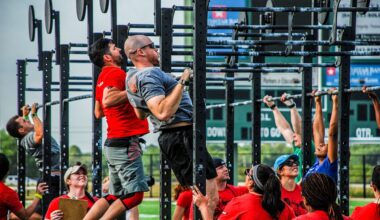Tracking Progress with Fitness Software during Online Classes
In the digital age, tracking your fitness journey is essential, especially during online classes. Fitness software integrates seamlessly with various online platforms, enabling personalized tracking of individual progress. Users can monitor metrics like heart rate, calories burned, and muscle engagement throughout workouts. Most applications provide dynamic feedback in real-time, which is crucial for maximizing workout efficiency. Additionally, many fitness apps allow users to set specific goals and milestones. Each achievement encourages continued commitment to a fitness regimen. Furthermore, these applications often include community features. Users can connect with others, sharing insights, challenges, and successes. This social aspect can increase motivation significantly. Fitness apps also typically offer a library of classes, from HIIT to yoga, presenting options that cater to all preferences. Moreover, integrating nutrition tracking enhances the overall effectiveness of the program. By logging meals and calories, users remain aware of their dietary habits and how they impact fitness goals. Lastly, wearable technology, like smartwatches, can further enhance the data collection process for optimal tracking. With such integrated tools, achieving fitness objectives becomes much more accessible and engaging.
The Benefits of Fitness Tracking Software
One of the most significant advantages of using fitness tracking software during online classes is the ability to visualize progress. Many users find that seeing tangible results drives them to push harder. The software provides various visual displays such as graphs and charts. These tools enable users to assess performance over time easily. Additionally, the motivational quotes and tips often integrated into these platforms can bolster self-discipline. As users advance, they may encounter challenges, making this encouragement even more crucial. Tracking workouts can also help identify patterns in exercise habits. Users can learn which routines lead to increased performance or greater fatigue. This knowledge facilitates better planning of future workouts. Furthermore, comprehensive tracking can lead to better injury prevention. By monitoring how the body responds to different workouts, users can adjust their routines to prevent overexertion. Many fitness apps also offer reminders for workouts and recovery days, ensuring users stay consistent without burning out. In terms of accessibility, fitness tracking software is often available on both mobile devices and desktops, making it convenient to check progress anywhere at any time. With these features, fitness journeys become more enjoyable.
Another essential function of fitness software is goal setting and its subsequent tracking. Many applications allow users to create tailored, achievable fitness goals, which could range from weight loss to muscle gain. By breaking down overall objectives into smaller segments, users experience a sense of accomplishment at each milestone. The structured environments these apps provide keep users focused and accountable. Users become more determined not only to meet goals but also to exceed them as tracking offers positive reinforcement. Additionally, many apps allow for integration with third-party devices for more accurate readings. By pulling data from wearable tech, users receive a comprehensive view of their fitness journey, enhancing motivation. Moreover, personal trainers often leverage these tools during online classes, providing personalized advice based on real-time data. This tailored approach helps individuals adapt their fitness routines for maximum effectiveness. Many fitness applications also include forums and support groups, fostering a sense of community. Engaging with others who share similar goals can provide motivation and encouragement. As a result, software not only tracks fitness but also builds a foundation for lasting changes in lifestyle and health.
Interactive Features Enhancing Online Classes
Fitness software seldom relies solely on tracking purposes; its interactive elements significantly enhance the online class experience. Most applications feature live feedback systems during sessions, permitting users to grasp their form or technique immediately. This capability is vital for individuals participating in online classes, where instructor-aided corrections might not always occur. Users gain confidence knowing they can improve their form while receiving instantaneous feedback. Furthermore, many programs incorporate gamification strategies. These strategies may include challenges, competitions, and rewards systems that add an engaging layer to the workouts. This concept encourages users to compete against themselves or others, increasing enthusiasm for each session. Many platforms also feature specialized workshops or themed classes. Participants of all fitness levels can find motivation and enjoyment in these curated experiences. Some of these interactive components allow for personalized training plans adjusted to users’ preferences and fitness levels. This level of customization ensures that everyone remains engaged during their workouts. By integrating elements that promote interaction, fitness software cultivates an engaging and supportive online class environment. Hence, users are more likely to maintain their dedication to their fitness journeys.
As fitness software continues to evolve, the integration of Artificial Intelligence (AI) enhances online classes. AI features analyze user data, offering tailored exercise recommendations based on personal progress and preferences. This custom programming requires minimal input by users, ensuring a simplified experience. Participants benefit from intelligent suggestions, adjusting workout intensity according to fatigue or performance. Moreover, AI-driven tools can anticipate potential challenges. By recognizing plateauing habits, the software can propose varied routines that keep engagement high and results steady. Enhanced progress tracking leads to a better understanding of what strategies work best to stay healthy, making these adaptations crucial. Users may also enjoy smart alerts regarding upcoming virtual classes or planned workouts. By keeping individuals informed, these features maintain accountability and help users stagger workouts accordingly. Additionally, many fitness applications enable voice-guided workouts, simplifying the home exercise experience. Users can follow along without constantly checking their screens, thereby maintaining focus. Integrating advanced technology into fitness apps not only boosts overall usability. It also ensures that online classes remain fresh, exciting, and results-driven. Thus, leveraging AI within fitness software continues to revolutionize how individuals engage with their fitness journeys.
Enhancing Social Interaction Through Fitness Software
One of the most significant transformations fitness software provides is in social interaction within online classes. Traditionally, physical gyms fostered community in-person, while now virtual environments create their own unique engagement opportunities. Fitness software often includes features for connecting with friends, creating accountability partnerships, and sharing workouts on social media platforms. Such connectivity allows users to experience the supportive atmosphere typically found in brick-and-mortar gyms. Additionally, many apps enable group challenges or competitions that encourage camaraderie and participation. These group activities motivate users to take fitness seriously while appreciating shared experiences. By being part of a community, individuals become more likely to persist against challenges and celebrate achievements collectively. Some applications also allow users to share progress photos and personal stories. Doing so not only fosters openness but enables others to learn from individual experiences. Enhancing communication through in-app messaging provides another layer of connection among participants. Users can provide one another with motivation and encouragement in real-time. Overall, fitness software enriches social interaction, which enhances engagement and improves fitness outcomes. This virtual support system promotes consistency in workouts, contributing significantly to achieving fitness goals.
Future Developments in Fitness Tracking Software
The future of fitness tracking software promises exciting innovations that will further influence online classes. One area seeing substantial growth is augmented reality (AR). AR applications can immerse users in realistic workout environments, providing an exciting twist to traditional exercise routines. This technology creates interactive workouts that boost user enjoyment tremendously. Additionally, more sophisticated data analytics will enable apps to provide deeper insights into users’ habits and potential improvements. As natural language processing technology evolves, users will potentially interact with software using conversational commands for a smoother experience. This integration will eliminate the need for navigating complicated menus. Remote personal training will also gain traction, where personal trainers can access users’ data to devise personalized programs remotely. Furthermore, the integration of health data from wearable devices will enhance the depth of workout analyses. By utilizing these advancements, fitness applications will optimize individual user experiences, allowing them to meet their objectives more efficiently. Innovations are proving crucial in promoting long-term engagement and success. As these technological developments unfold, they promise to reshape the direction of fitness software significantly.


